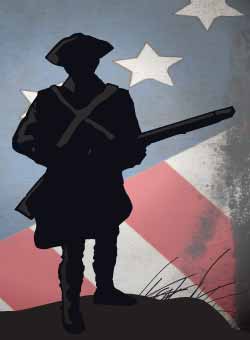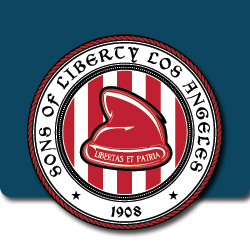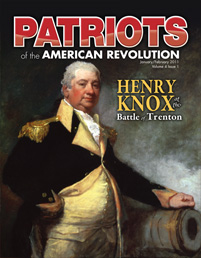
huzzah! The Liberty Tree's 30th Year!
Newsletter content below: just click on a title bar to open the story.
This article reprinted here by gracious permission of the author, Christopher L. Russell. All rights reserved.
Dr. Edward Bancroft: The Man Who Spied on Benjamin Franklin.
Originally printed in Patriots of the American Revolution: Dec. 2010 Volume 3 Issue 6
By Christopher L. Russell
 It was Tuesday evening and rapidly approaching half past nine. As he had done so on previous Tuesdays, a staff member of the British embassy in Paris made his way to the Tuileries Garden. There, in the South terrace, he saw the large tree with a hole at its base. Within the hole was a white card attached to a wooden peg---a marker visible in the dark. The courier reached into the hole, pulled on a string, and reeled up a glass bottle filled with important documents about the American delegation in Paris---papers that outlined the delegates' political endeavors, ongoing strategies of the revolution in America, troop and ship movements, and other confidential bits of information.
It was Tuesday evening and rapidly approaching half past nine. As he had done so on previous Tuesdays, a staff member of the British embassy in Paris made his way to the Tuileries Garden. There, in the South terrace, he saw the large tree with a hole at its base. Within the hole was a white card attached to a wooden peg---a marker visible in the dark. The courier reached into the hole, pulled on a string, and reeled up a glass bottle filled with important documents about the American delegation in Paris---papers that outlined the delegates' political endeavors, ongoing strategies of the revolution in America, troop and ship movements, and other confidential bits of information.
After he replaced the bottle with new instructions inside, the courier carried the document to the British Embassy.
If he were to be stopped, the courier's papers would simply appear to be the latest record of an illicit love affair. One would not have seen the hidden message written in invisible ink, between the lines, masking in plan sight the information British sought.
The documents were given directly to British diplomat Lord Stormont, who alone held the "developer" that could reveal the invisible information gathered by the British double agent Dr. Edward Bancroft-- codename "Dr. Edward Edwards--- who had managed to secure a position as secretary to Benjamin Franklin and the American delegation in Paris.
Origins of a Secret Agent
Edward Bancroft was born in Westfleld Massachusetts, on January 9, 1744. Tragedy struck his life at age two when his father passed away. His mother remarried and the family moved to Connecticut, where Bancroft studied under schoolmaster Silas Deane, future diplomat and delegate to the Continental Congress.
Bancroft also apprenticed for a time under a medical physician before leaving for Surinam in July of 1763, at the age of 19. There he found work as a doctor of sorts, and conducted studies of tropical plants and animals, including "torporific eels," in the area before traveling again.
Eventually he arrived in London and began studying medicine again at St. Bartholomew's Hospital. Over the next decade he also worked as a stock speculator and published An Essay on the Natural History of New Guiana, in South America, in 1769. The publication piqued the curiosity of colonist in the British capital named Paul Wentworth, who contracted Bancroft to survey his land in Surinam. Bancroft acquiesced--and on his return, he met Benjamin Franklin, then a colonial representative in London.
Franklin and Bancroft appear to have gotten along famously. The men had a great deal in common. Both had run away from apprenticeships in their youth, both were "self-made" men and inventors, and both were interested in medicine and scientific theories. Due in part to his friendship with Franklin, Bancroft was elected to London's Royal Society. Furthermore, Bancroft agreed to spy on the British for Franklin; Bancroft apparently had social connections with men in Britain's political and military circles.
After Franklin left London in 1775, Bancroft remained, 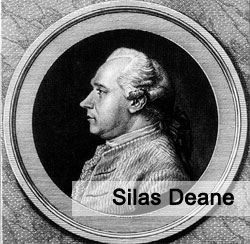 presumably still spying for Franklin. Such was the Founding Father's trust in Bancroft that when the doctor's old schoolmaster, Silas Deane, was sent to France on a diplomatic mission in June of 1776, Franklin instructed Deane to contact Bancroft.
presumably still spying for Franklin. Such was the Founding Father's trust in Bancroft that when the doctor's old schoolmaster, Silas Deane, was sent to France on a diplomatic mission in June of 1776, Franklin instructed Deane to contact Bancroft.
The two men reunited in Paris that July, and Deane soon informed Bancroft of his real reason for being in France--to secretly obtain French aid for the colonial struggle, and to inspire France to openly join the war against Britain. There is reason to believe that Bancroft served as Deane's interpreter during some early meeting with the French. However, Deane's confession seems to have been the catalyst for Bancroft's eventual betrayal of the Americans, for Bancroft had hoped for some sort of reconciliation between the colonies and Britain and knew that France's entry into the war would make this impossible. Before returning to London, Bancroft assured Deane that he would continue to spy for the Americans. However, once back in England, Bancroft met his old associate, Paul Wentworth, who was now a British spy. Wentworth approached Bancroft with a proposal that Bancroft become a double agent, and a meeting was arranged between Bancroft, Wentworth, William Eden--Chief of the British Secret Service-- and Lords Suffolk and Weymouth. Bancroft was ordered to associate with Franklin (who was now in Paris) and relay intelligence back to the British in return for an annual salary. Bancroft was also given the barely passable code name of "Dr. Edward Edward." Naturally, a contract outlining the details and expectations of his service was signed. In sum, the information requested by the British Secret Service included: "The progress of the treaty with France and of the assistance expected...The same of Spain and of every other court in Europe...The means of obtaining credit, effect and money and the channels and agents used... Franklin's and Deane's correspondence with Congress in secret...Descriptions of ships and cargos, the time of sailing and the ports bound to...The intelligence that may arrive from America."
The Mission Begins
Franklin soon made Bancroft the official secretary of the American delegation in Paris. Since both men stayed in the Passy area of the capital, Bancroft was privy to much sensitive information about the French and American governments. Bancroft would record this information in invisible ink between the lines of fake letters and place the letters in the bottle hidden in the Tuileries Garden every Tuesday evening at 9:30. He would then return later in the evening to receive his latest instructions.
Using this method, Bancroft was able to supply a steady stream of intelligence to the British. For example, it is reported that King George lll knew that France and America had signed treaties just 48 hours after the fact, thanks to the double agent.
Although Bancroft's mission in Paris went rather smoothly, it was not completely without scrutiny because American delegates John Adams and Arthur Lee disliked him. While Adams himself never actually accused or suspected Bancroft of spying, he certainly did not hold him in high regard; Adams was correct in his assumptions that Bancroft used "inside information" for personal gain in stocks and other dealings with the French.
Lee on the other hand, openly accused Bancroft of leaking information to the British. Unfortunately, Lee had previously accused so many other men of similar crimes that his credibility had diminished and the accusations weren't taken seriously. Nevertheless, Bancroft responded in vehement protest, even challenging both Arthur Lee and his brother, William, to duels that never materialized.
Furthermore, Franklin had received a warning in candid letter from a friend named Juliana Ritchie: " ... I proceed to the purpose of this---which is to inform you Sir---that you are surrounded with spies --- who watch your every movement who you visit--- & by whom you are visited---of the latter there are who pretend to be friends to the cause of your Country but that is a mere pretense---your own good sense will easily infer---the motive of their conduct. One party assures---that you are seeking aid & support from this Kingdom for the other party---insinuate that you have given up that Cause & are making the best terms you can for the private advantage of your own family connections & friends..."
To this Franklin replied: "I have long observed one rule which prevents any inconveniences from such practices. It is simply this: to be concerned in no affairs I should blush to have made public, and to do nothing but what spies may see and welcome. When a man's actions are just and honorable, the more they are known, the more his reputation is increased and established. If I was sure, therefore, that my valet de place was a spy, as be probably is, I think I should probably not discharge him for that, if in other respects I liked him." Whether Franklin really suspected that Bancroft was a double agent is unknown. Regardless,the British took steps to ensure Bancroft's continued success. Because Franklin and Deane sent Bancroft on regular intelligence-gathering trips to London, the British Secret Service was able to stage Bancroft's brief "arrest," all in the hopes of convincing the American delegation in Paris of his allegiances. The ruse appears to have worked quite well. As Silas Deane wrote in a letter: "...Dr Bancroft is arrested in London for corresponding with and assisting us-- This worthy man is confined in the Bastille of England, for the suspension of the Habeas Corpus has enabled the wicked tyrant and his slaves to make a Bastille of every prison in England. I feel more for Dr. Bancroft than I can express; be deserves much from us; consequently will be pursued with the utmost vigor by them, though nothing capital, not even the correspondence can be proved. I wish we may be able to assist him."
Evaluation
Remarkably, Bancroft was never truly exposed as a double agent during the American Revolution, and afterwards he lived in London to the ripe old age of 77. It was only in 1889--78 years after his death---that his role was made clear when the secret papers of British spy chief William Eden (who later became Lord Auckland) were published. The fact that Edward Bancroft was a double agent is not questioned today. However, what may be questioned is his effectiveness. An article in the archives of the Central Intelligence Agency states that "...the measure of excellence is success; and [Bancroft's] method proved effective and safe for several years."
The repost continues:
"We think of Franklin as one of the shrewdest diplomats this country has ever produced and a man who never got the bad end of a bargain; but of all the dupes of history surely none can best his record in the Bancroft case."
Yet this may be unfair. Although we don't know for sure if Franklin suspected Bancroft, we do know that many historians consider Franklin to be one of the "shrewdest" American diplomats. There is a school of thought that believes that had Franklin overreacted to rumors of spies in his circle, he would have trusted no one. This, in turn, would have jeopardized the goals of the American delegation in Paris. Or perhaps a suspecting Franklin wanted to keep his friends close---and his enemies closer. One should also note that during the entire time Bancroft was a spy in Passy, nothing of great consequence was ever achieved or lost as result of his activities. Franklin's most renowned biographer, Carl Van Doren believes that, "On the whole Franklin profited more by the British spies that he lost." And the measure of excellence truly is success,then excellence was certainly achieved in 1778---when Benjamin Franklin signed the treaty of Alliance with France---and again in 1782 when he successfully negotiated and signed the Treaty of Paris, both times regardless of any damage a double agent may have caused.
If you enjoyed this article, consider subscribing to the magazine. Click the cover below to learn more:
Once again, our annual Christmas party was made an elegant affair by the gracious hospitality of the Mohlers. An important part of any Society is fellowship with other members, and all would agree that this evening was spent enjoyably in the company of fellow students of history, philosophy and genealogy. If you didn't attend, you missed something special.
(Photos: First VP Ron Johnson)
Well, you do! Great Chapters start with great members. We have over 100 members in our Chapter for 2011. Thank you for your continued dedication to the ideals of the SAR. We want to have something to engage every Compatriot, so we will be expanding our efforts and broadening our outreach.
The following is a list we'll be reviewing at every Chapter meeting. It's what great Chapters are doing throughout the state. Let's ensure we stay on track to be a shining light for the SAR in Southern California.
Pick a program and get involved!
Meetings
- Number of Chapter Meetings
- Joint Chapter meeting with another SAR DAR, or CAR Chapter
- Number of guests attending meetings
- Number of Members Attending Meeting
Publicity
- Newspaper and magazine articles appearing in print that contain a specific reference to SAR
- Color Guard Photo
- SAR mentioned in TV or radio spot
- SAR member interviewed
Members
- New Members
- Supplementals
- Youth Registrants
- Junior Members
- CASSAR Life Members
Medals/Certificates
- Awarded to non-SAR members
- Medals and Certificates to members of another Chapter
Chapter Activities
- Color Guard appearance
- School presentation
- Plaque dedication
- Memorial or funeral service
- Placement of a grave marker
- Other similar event
- Chapter members participate in another Chapter’s activity
- CASSAR Meeting Host Chapter
- Attendance at NSSAR Congress or Leadership Meeting
Community Service
- A Chapter participates in a non-SAR program with a Patriotic or Revolutionary War theme.
CASSAR Programs
- Knight Essay Contest
- NSSAR Americanism Middle School Brochure
- Eagle Scout Scholarship
- Valley Forge Teacher
- JROTC Outstanding Cadet
- NSSAR Americanism Elementary School Poster Contest
Publication
- Distribution of patriotic or historical publication such as a booklet or CD to school classes or similar groups
To further the study of the American revolution, your webmaster is reviewing out-of-print texts to bring quality scholarship to you. Over the next months, I will publish a commentary on each battle of the Revolution in order of occurrence.
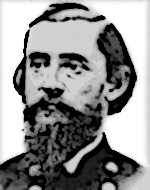
The author of each is Colonel Henry B. Carrington, MA, LLD, who wrote "Battles of the American Revolution 1775-1781." Published by AS Barnes & Company in 1876. The work is in the public domain, and not subject to copyright. He was professor of natural science and Greek at the Irving Institute in Tarrytown, New York, from 1846 to 1847. Under the influence of the school's founder, Washington Irving, he wrote "Battles of the American Revolution." Carrington subsequently became adjutant general for Ohio, mustering ten regiments of militia at the outbreak of the Civil War and organizing the first twenty-six Ohio regiments. Learn more>>

THE NORTHERN CAMPAIGN. PRELIMINARY OPERATIONS.
No expedition during the American Revolution had less elements of permanent value than those which were undertaken against Canada during the year 1775. Great results were anticipated, but none were realized. The obstacles were too substantial, and failure was inevitable. Wonderful endurance and great physical courage were manifested, and these were accompanied by a prodigious amount of faith, but there was neither ability nor opportunity for works commensurate with the faith. Certain Acts of Parliament, known as the Canadian Acts, were as offensive to Canadians as other legislation was to Americans; but the former were not pressed to the extremity of armed resistance. The people themselves having no harmony of religious or political views, were equally divided in language and race.
Neither did the Canadians invite the aid of the colonies. The hypothesis that Canada would blend her destiny with that of New England, and would unite in resistance to the crown, certainly involved some identity of interest as well as of action. But the characters of the two people were too unlike to be unified by simple opposition to English legislation, and Canadians had no antecedents such as would prompt a hearty sympathy with New England and its controlling moral sentiment. Neither was there such a neighborly relation as admitted of prompt and adequate aid from one to the other, in emergencies calling for a combined effort.
As a base of operations for a British army moving upon the colonies, Canada had the single advantage of being less distant from England than an Atlantic base, and many supplies could be procured without the expense and delay of their transportation across the Atlantic; but between Canada and the American colonies there was an actual wilderness.
Hence a British offensive movement from Canada involved constant waste of men and materials, a deep line through an uninhabited or hostile region, and such a constant backing as was both inconsistent with the resources of the base, and with a corresponding support of armies resting upon the sea coast.
The British government was not ready for operations so extensive and so exhaustive of men and treasure; neither did it realize the necessity for that expenditure. 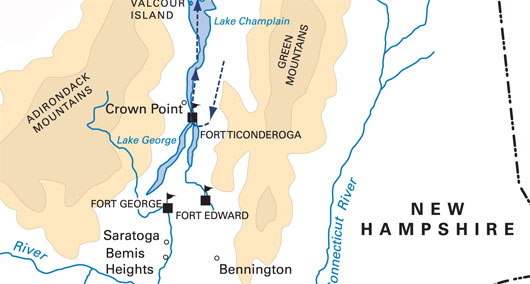 There were two alternatives, one illustrated by General Carleton's plan, viz., to hold the forts of Lake Champlain, as advanced, defensive positions; and the other, that of Burgoyne, to strike through the country and depend upon support from the opposite base.
There were two alternatives, one illustrated by General Carleton's plan, viz., to hold the forts of Lake Champlain, as advanced, defensive positions; and the other, that of Burgoyne, to strike through the country and depend upon support from the opposite base.
The true defense of the colonies from such expeditions, depended upon the prompt seizure and occupation of the frontier posts. An American advance upon Canada, was not only through a country strategically bad, but the diversion of forces for that purpose endangered the general issue, and entrusted its interests to the guardianship of an army already insufficient to meet the pressing demands of the crisis.
The occupation of New York in 1775, by an adequate British force, would have infinitely outweighed all possible benefit from the complete conquest of Canada. At the very time when Washington could hardly hold the British garrison of Boston in check, when he had an average of but nine rounds of ammunition per man, he was required to spare companies, ammunition, and supplies for a venture, profitless at best, with the certainty that reinforcements could not be supplied as fast as the enemy could draw veteran regiments from Great Britain and Ireland, to defend or recover Canadian soil.
In giving a rapid outline of this first attempt of the colonies to enlarge the theatre of active operations, it should be noticed that the initiative had been taken before General Washington had been elected commander-in-chief, and that Congress itself precipitated the final movement.
A passing thought is noted, as historic characters now come into view.
The crater of passion casts out every kind of element that has been seething and boiling under pressure. So the impulse from Lexington and Concord brought to the surface some elements of great variety of value and endurance. Arnold, then living at New Haven, and commanding the company still known as the "Governor's Guards," was so heated, that he could not wait for orders or preparation; but after taking ammunition by force, started with forty of his men for Cambridge on the third day after those skirmishes occurred.  He rushed for Ticonderoga without men, as soon as he could handle a commission. He was one of the heroes of Quebec.
He rushed for Ticonderoga without men, as soon as he could handle a commission. He was one of the heroes of Quebec.
Lee was another man, who with hardly less ambition, eccentricity, and lack of moral force, had every volcanic symptom, with more of military knowledge, and sufficient worldly wisdom to be careful that Congress made up the loss of income which his patriotism would involve. What Arnold was to the northern expedition, Lee fore-promised for a more rational, and a truly legitimate expedition to the southern colonies, when they were afterwards threatened by Clinton and Parker.
This digression purposely associates with two prominent early military movements, the two men who started forth at the outset as meteoric lights, challenging place as stars of the first magnitude, and going out in darkness.
The two expeditions to Canada only anticipated the fate of their leaders. Both expeditions are associated with other and related operations which give character to the campaign of 1776, the first of the war.
The facts are as follows :
Arnold arrived at Cambridge, and immediately proposed to the Committee of Safety, that he should be sent to capture Ticonderoga. He was promptly commissioned as colonel, was supplied with money, powder, lead, and ten horses, and was authorized to enlist not to exceed four hundred men for the enterprise. Learning that a similar expedition had already started, he entrusted his recruiting to parties selected for the purpose, and joined the other enterprise at Castleton, its place of rendezvous. Here he found Ethan Allen in command, and after a vain effort to assert authority by virtue of his commission, he followed its destinies as a volunteer. 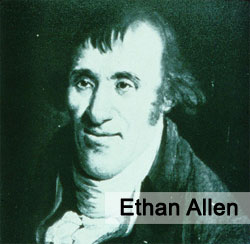 Upon reaching the head of Lake Champlain, it was found that boats could not be procured for the whole force, and Allen, who took the lead with less than ninety men, crossed over to the fort, surprised the small garrison by night, and on the morning of the tenth day of May took command of Ticonderoga. Nearly two hundred cannon of all sorts were included among the trophies of the capture. The original inventory of trophies in the handwriting of Arnold, is now in the possession of Dr. Thomas Addis Emmett, of New York. Seth Warner, a volunteer at the battle of Bunker Hill, and afterwards distinguished in active service, was associated with Allen in this enterprise. On the morning of the twelfth of May, Warner embarked a small force in boats, and captured the fort at Crown Point, which had been left with only a nominal garrison to protect the public property.
Upon reaching the head of Lake Champlain, it was found that boats could not be procured for the whole force, and Allen, who took the lead with less than ninety men, crossed over to the fort, surprised the small garrison by night, and on the morning of the tenth day of May took command of Ticonderoga. Nearly two hundred cannon of all sorts were included among the trophies of the capture. The original inventory of trophies in the handwriting of Arnold, is now in the possession of Dr. Thomas Addis Emmett, of New York. Seth Warner, a volunteer at the battle of Bunker Hill, and afterwards distinguished in active service, was associated with Allen in this enterprise. On the morning of the twelfth of May, Warner embarked a small force in boats, and captured the fort at Crown Point, which had been left with only a nominal garrison to protect the public property.
At this juncture, Arnold reasserted his right to command, but the colony of Massachusetts recognized the prior claims of Allen. Having been joined by fifty recruits whom his agents had enlisted, he embarked this force upon a schooner belonging to Captain Skene, placed cannon on board, and captured St. John's with its nominal garrison, and a king's sloop then lying in the river near the fort.
Allen, who had started with one hundred and fifty men in bateaux upon the same errand, was outstripped by the schooner, and met Arnold, as he returned from the conquest. An attempt to occupy St. John's permanently, was given up as soon as advised that adequate forces had been ordered from Canada to maintain the post.
Arnold's force gradually increased to one hundred and fifty men. With these he manned a small fleet, and assumed command of this miniature navy as well as of Crown Point. Protests against his assumption of so large authority, brought a committee from the Connecticut Provincial Assembly; and Massachusetts decided that the conquest belonged to Connecticut, so that Arnold was not rightfully in command. The latter colony at once forwarded four hundred men to garrison the two posts. Arnold discharged his men, and returned to Cambridge, highly offended. Before leaving Crown Point in June, he wrote to the Continental Congress stating that General Carleton's force in Canada was less than six hundred men, asking for the command of two thousand troops for the capture of the whole of Canada, and assumed responsibility for success. He had formerly traded with citizens of Quebec, was familiar with the city, and claimed to have assurance of hearty support if he could have a small nucleus for further operations. On the second day of June, Allen made a proposition to the Provincial Congress of New York, embodying a similar undertaking.
Allen and Warner also visited Congress, and requested authority to raise new regiments. This authority was not given, but a recommendation was made to the Provincial Congress of New York, that the "Green Mountain boys," so styled, should be recognized as regular forces, with the privilege of electing their own officers.
A formal expedition against Montreal was also authorized, and Generals Schuyler and Montgomery were assigned to its command.
The force to be employed consisted of three thousand New York and New England troops, which were ordered to rendezvous at Ticonderoga during the month of August. Allen and Warner joined this command.
During the same month a committee from Congress visited Cambridge, and persuaded General Washington to send a second army to Canada, via the Kennebec river, having for its objective the capture of Quebec. Gardner, a town on the Kennebec, was made the base of departure: and skillful carpenters were sent forward to prepare two hundred bateaux for the use of the troops.
Arnold prominently urged the movement, earnestly solicited, and finally received the command, with the rank of colonel in the Continental army. Ten companies of New England troops under Lieutenant-colonels Enos and Christopher Green, and Majors Meigs and Bigelow, and three companies of riflemen, one from Virginia, and two from Pennsylvania, under the command of captain, afterwards General, Daniel Morgan, composed this army of invasion. The aggregate force was eleven hundred men, furnished with rations for forty-five days. Aaron Burr, then but nineteen years of age, accompanied the expedition.
The Chapter needs your input! In viewing other SAR Chapter sites, I came across something that’s a great idea: publishing the biographies of the Chapter member’s Patriot Ancestors. This is not only of interest to the other Chapter members, it serves as an important resource to our cousins out there who are searching for their ancestors. What better way to honor the memory of those who sacrificed for our nation’s founding that to tell their story.
The reason I chose the illustration of a faceless patriot used for our web site is that most of us do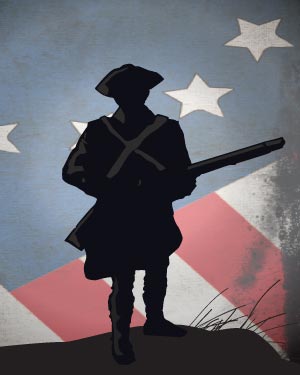 n’t know what our ancestors looked like. Their features are lost to us. However, with a little work, we can all find out where they were and what their life was like at the time of the Revolution, based on contemporary accounts of the people around them. This brings them to life and makes the Revolution more real to all of us.
n’t know what our ancestors looked like. Their features are lost to us. However, with a little work, we can all find out where they were and what their life was like at the time of the Revolution, based on contemporary accounts of the people around them. This brings them to life and makes the Revolution more real to all of us.
So, I invite all Chapter members to submit a biography for each of their Patriot Ancestors. Each can be as long or as short as you like (that’s another advantage of the Web). You can use illustrations as well, but keep in mind the must be your own photos, or images in the public domain.
We already have some posted on our Web site, so take a look and get started on yours today!
